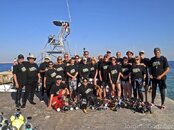Look at the link for M43 lenses from Olympus and Panasonic shot using the same testing process and you will see much better results,
Micro Four Thirds Lens Tests so
the question becomes are you looking to buy a great sensor or a great system. This question has already been answered by DPReview who has given the E-M5 system its highest rating, gold and has commented that this is the best M43 camera yet and a contenred for best mirrowless camera of all.
Can't agree with you more.
A lot of people have this notion that a camera with an APS-C sensor is automatically better than one with a m4/3 sensor. While the absolute sensor area of APS-C is indeed 20% larger, the difference in IQ attributable to this difference in area is actually quite small. Case in point: The E-M5 actually has better dynamic range
and cleaner ISO3200 than my 7D (18MP APS-C sensor, for whose not familiar with Canon DSLRs)!!
Also, sensor performance is not the only thing that makes a camera great for UW photography. Other things like AF performance, ability to shoot RAW, ease of setting custom WB, shot-to-shot time, or even the simple ability to set shutter speed/aperture independently can matter just as much.
Back in its days, the Fuji F30/F31 had a larger sensor than just about all other non-DSLR cameras. Superior low-light performance was indeed its main claim to fame. However, I was very frustrated when I brought my F30 underwater. Its already-slow-on-land AF became almost unusable once one goes below 40 ft. It simply could not find enough contrast to achieve focus once the reds and yellows were gone, and everything was a shade of blue (or green).
For the same reason, I suspect the Fuji X-Pro1 will make a
horrible camera underwater, even though its APS-C sensor (without an anti-alias filter) is supposedly able to outresolve a Canon 5D2 (a 21MP full-frame sensor, for those not familiar with Canon DSLRs).
Don't get me wrong, Sony has some nice lenses FOR THEIR COST like the 30mm macro. But for underwater photography and that is what these threads are about, hands down Olympus/Panasonic has by far the better lens set. So the question becomes are you wanting to buy a sensor or a system.
Again, I can't agree with you more.
Once one enters the realm of interchangeable lens, one should really think about the entire system, rather than the camera/body alone. My 6-year-old, entry-level Rebel XTi mated to a 300 mm/4L prime telephoto lens will take WAY better photos on a safari than the latest 5D3 with a consumer 75-300 zoom.
Of course, underwater lens selection usually boils down to just two main themes: UWA/FE and macro. However, as a land photographer, I need to consider the camera/system's capability in many more situations, such as portraiture, sports, landscape, architecture, etc.
There is no doubt m4/3 offers WAY more possibilities compared to NEX or Fuji X-Pro.
Now, you don't mind, I have a few questions of my own....

I'm fully aware of all the reviews available on-line, but Phil is the first to be looking at it from 'our' angle. . . hopefully

As terson mentioned, I am hoping you can share your thoughts on the E-M5 (and the mZuiko 12-50), particularly in how they might fare underwater.
1. You mentioned before the standard 14-42 is cheap, and works well within the included port. You also mentioned the Panasonic "pankcake" 12-42 Power Zoom is a better lens (presumably from the IQ perspective).
Can you comment on how the mZuiko 12-50 compares to those two 12-42 zooms in terms of:
- IQ
- AF speed/accuracy
- ease of zoom/zoom speed?
The Photozone review is not out yet, but
LensTip seems to think the 12-50 is average-at-best in terms of IQ.
The Panasonic 12-42 Power Zoom can zoom surprisingly fast at its maximum speed, perhaps no slower than one can zoom any mechanically-coupled zoom lens. Howevere, I've never zoomed a lens underwater using zoom gears.
2. Can you comment on how easy it is to set custom WB on the E-M5?
The Canon S95/S100, which is what I use underwater right now, allows one-button-push setting of custom WB, which is great. (I shoot RAW+JPEG, and I like having my JPEGs come out with half-decent colours to start with. Also, with available-light videos, one cannot count on RAW afterwards for WB.)
3. Can you speculate on the 12-50's usability with wet lenses?
Previous Olympus ports (or were they ZEN ports?) apparently have 67mm threads for wet lenses. I know the 12-50 has internal zoom, so its length remains unchanged whether one is at the wide-angle end or the telephoto end. I would assume this is ideal for working with wet lenses, since the front element of the 12-50 can stay extremely close to the back of the wet lenses.
(I know eventually hard-core UW photographers will prefer to go with dedicated UWA/FE or macro lenses, but for someone still very new to UW photography, the thought of being limited to either UWA/FE or macro even before water entry is extremely unnerving -- the proverbial "what if a whale shark or manta ray were to swim by when I had my macro lens on?"

)
Many thanks in advance.







 )
)

